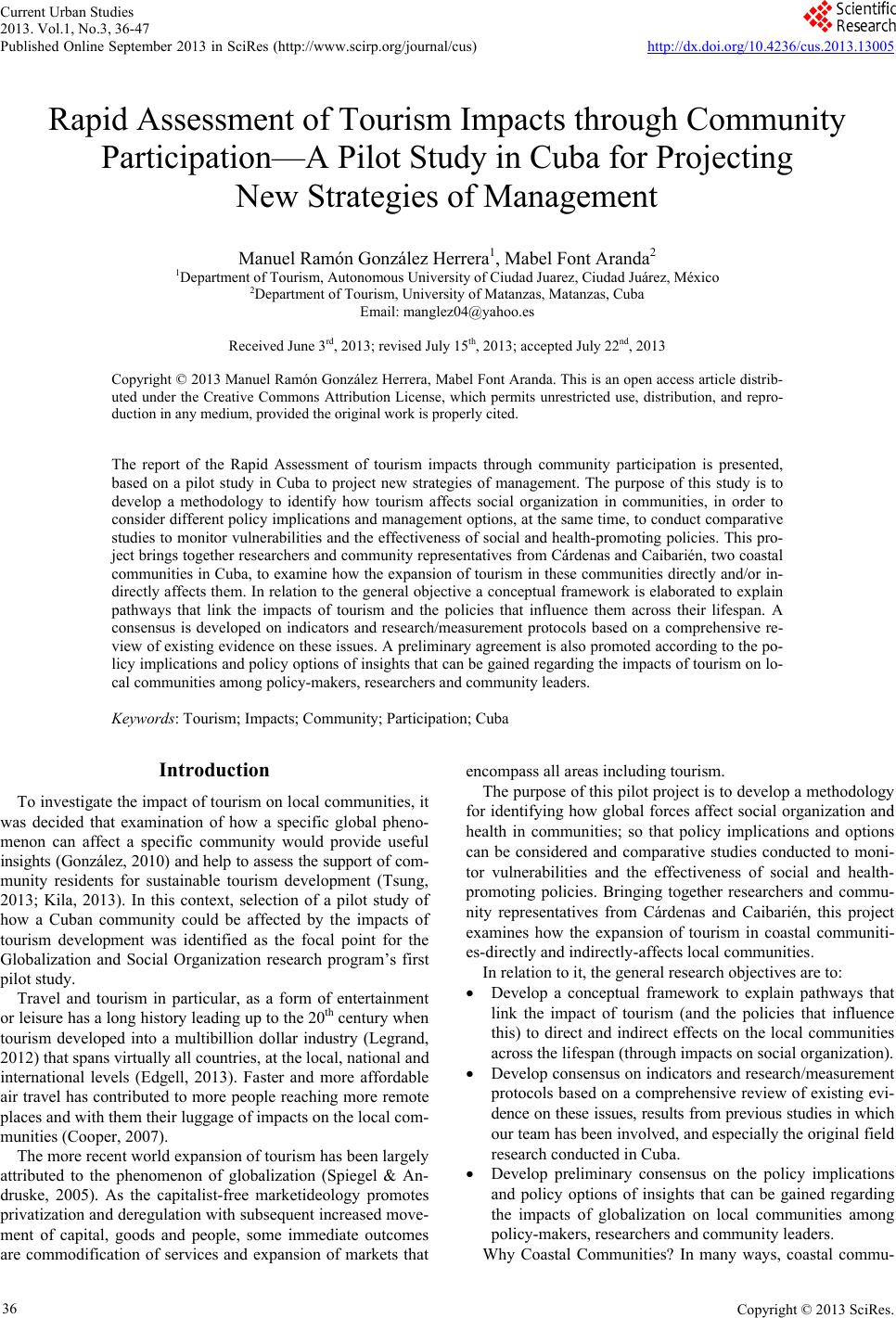 Current Urban Studies 2013. Vol.1, No.3, 36-47 Published Online September 2013 in SciRes (http://www.scirp.org/journal/cus) http://dx.doi.org/10.4236/cus.2013.13005 Copyright © 2013 SciRes. 36 Rapid Assessment of Tourism Impacts through Community Participation—A Pilot Study in Cuba for Projecting New Strategies of Management Manuel Ramón González Herrera1, Mabel Font Aranda2 1Department of T ourism, Autonomous University of Ciudad Juarez , Ciudad Juárez, México 2Department of T ourism, University of Matanzas, Matanzas, Cuba Email: manglez04@yahoo.es Received June 3rd, 2013; revised July 15th, 2013; ac cepted Ju ly 22nd, 2013 Copyright © 2013 Manuel Ramón González Herrera, Mabel Font Aranda. This is an open access article distrib- uted under the Creative Commons Attribution License, which permits unrestricted use, distribution, and repro- duction in any medium, provided the original work is properly cited. The report of the Rapid Assessment of tourism impacts through community participation is presented, based on a pilot study in Cuba to project new strategies of management. The purpose of this study is to develop a methodology to identify how tourism affects social organization in communities, in order to consider different policy implications and management options, at the same time, to conduct comparative studies to monitor vulnerabilities and the effectiveness of social and health-promoting policies. This pro- ject brings together researchers and community representatives from Cárdenas and Caibarién, two coastal communities in Cuba, to examine how the expansion of tourism in these communities directly and/or in- directly affects them. In relation to the general objective a conceptual framework is elaborated to explain pathways that link the impacts of tourism and the policies that influence them across their lifespan. A consensus is developed on indicators and research/measurement protocols based on a comprehensive re- view of existing evidence on these issues. A preliminary agreement is also promoted according to the po- licy implications and policy options of insights that can be gained regarding the impacts of tourism on lo- cal communities among policy-makers, researchers and community leaders. Keywords: Tourism; Impacts; Community; Participation; Cuba Introduction To investigate the impact of tourism on local communities, it was decided that examination of how a specific global pheno- menon can affect a specific community would provide useful insights (González, 2010) and help to assess the support of com- munity residents for sustainable tourism development (Tsung, 2013; Kila, 2013). In this context, selection of a pilot study of how a Cuban community could be affected by the impacts of tourism development was identified as the focal point for the Globalization and Social Organization research program’s first pilot study. Travel and tourism in particular, as a form of entertainment or leisure has a long history leading up to the 20th century when tourism developed into a multibillion dollar industry (Legrand, 2012) that spans virtually all countries, at the local, national and international levels (Edgell, 2013). Faster and more affordable air travel has contributed to more people reaching more remote places and with them their luggage of impacts on the local com- munities (Cooper, 2007). The more recent world expansion of tourism has been largely attributed to the phenomenon of globalization (Spiegel & An- druske, 2005). As the capitalist-free marketideology promotes privatization and deregulation with subsequent increased move- ment of capital, goods and people, some immediate outcomes are commodification of services and expansion of markets that encompass all areas including tourism. The purpose of this pilot project is to develop a methodology for identifying how global forces affect social organization and health in communities; so that policy implications and options can be considered and comparative studies conducted to moni- tor vulnerabilities and the effectiveness of social and health- promoting policies. Bringing together researchers and commu- nity representatives from Cárdenas and Caibarién, this project examines how the expansion of tourism in coastal communiti- es-directly and indirectly-aff e cts local commun it ies. In relation to it, the general research objectives are to: Develop a conceptual framework to explain pathways that link the impact of tourism (and the policies that influence this) to direct and indirect effects on the local communities across the lifespan (through impacts on social organization). Develop consensus on indicators and research/measurement protocols based on a comprehensive review of existing evi- dence on these issues, results from previous studies in which our team has been involved, and especially the original field research conducted in Cuba. Develop preliminary consensus on the policy implications and policy options of insights that can be gained regarding the impacts of globalization on local communities among policy-makers, researchers and community leaders. Why Coastal Communities? In many ways, coastal commu- 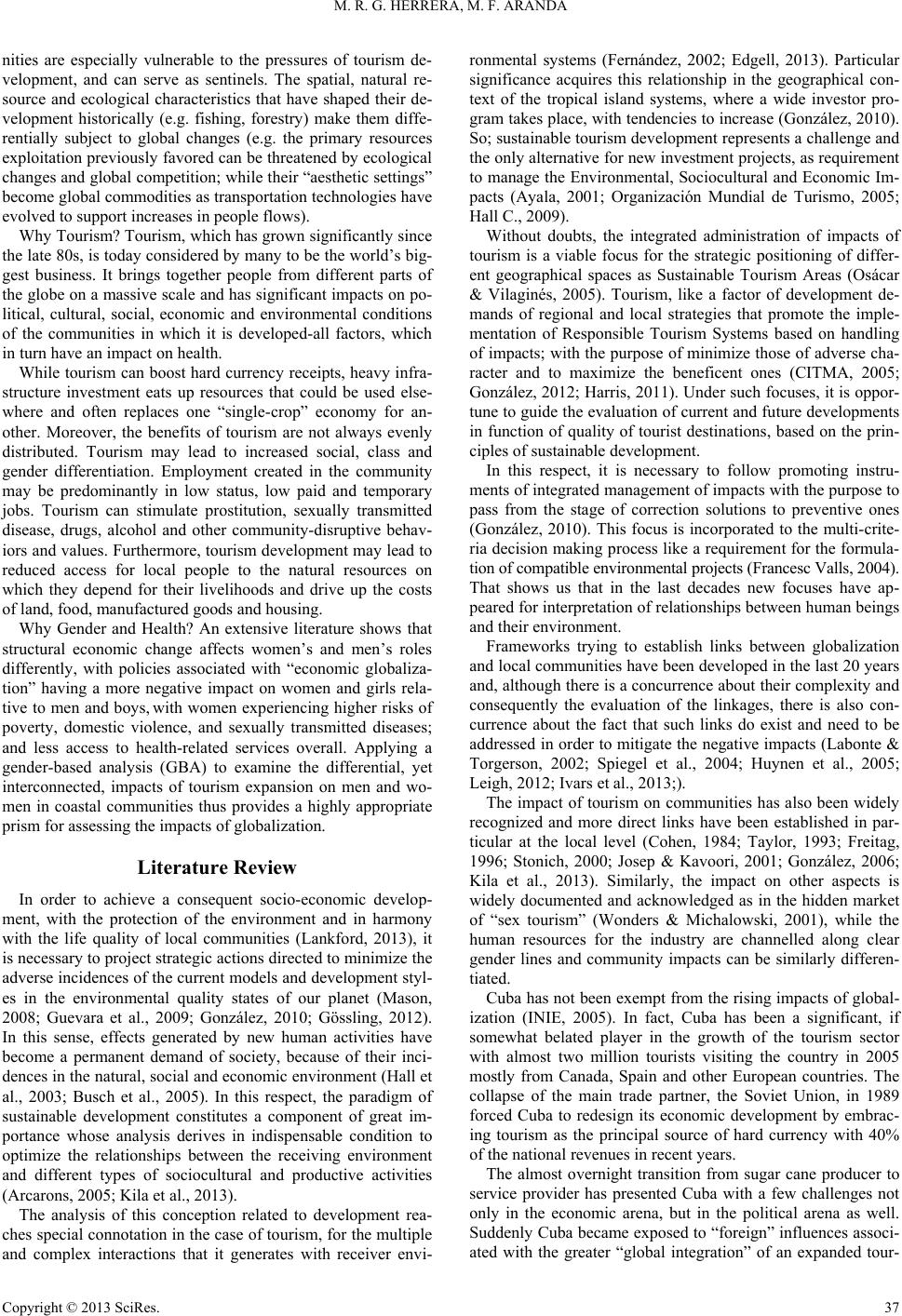 M. R. G. HERRERA, M. F. ARANDA nities are especially vulnerable to the pressures of tourism de- velopment, and can serve as sentinels. The spatial, natural re- source and ecological characteristics that have shaped their de- velopment historically (e.g. fishing, forestry) make them diffe- rentially subject to global changes (e.g. the primary resources exploitation previously favored can be threatened by ecological changes and global competition; while their “aesthetic settings” become global commodities as transportation technologies have evolved to support increases in people flows). Why Tourism? Tourism, which has grown significantly since the late 80s, is today considered by many to be the world’s big- gest business. It brings together people from different parts of the globe on a massive scale and has significant impacts on po- litical, cultural, social, economic and environmental conditions of the communities in which it is developed-all factors, which in turn have an impact on health. While tourism can boost hard currency receipts, heavy infra- structure investment eats up resources that could be used else- where and often replaces one “single-crop” economy for an- other. Moreover, the benefits of tourism are not always evenly distributed. Tourism may lead to increased social, class and gender differentiation. Employment created in the community may be predominantly in low status, low paid and temporary jobs. Tourism can stimulate prostitution, sexually transmitted disease, drugs, alcohol and other community-disruptive behav- iors and values. Furthermore, tourism development may lead to reduced access for local people to the natural resources on which they depend for their livelihoods and drive up the costs of land, food, manufactured goods and housing. Why Gender and Health? An extensive literature shows that structural economic change affects women’s and men’s roles differently, with policies associated with “economic globaliza- tion” having a more negative impact on women and girls rela- tive to men and boys, with women experiencing higher risks of poverty, domestic violence, and sexually transmitted diseases; and less access to health-related services overall. Applying a gender-based analysis (GBA) to examine the differential, yet interconnected, impacts of tourism expansion on men and wo- men in coastal communities thus provides a highly appropriate prism for assessing the impacts of globalization. Literature Review In order to achieve a consequent socio-economic develop- ment, with the protection of the environment and in harmony with the life quality of local communities (Lankford, 2013), it is necessary to project strategic actions directed to minimize the adverse incidences of the current models and development styl- es in the environmental quality states of our planet (Mason, 2008; Guevara et al., 2009; González, 2010; Gössling, 2012). In this sense, effects generated by new human activities have become a permanent demand of society, because of their inci- dences in the natural, social and economic environment (Hall et al., 2003; Busch et al., 2005). In this respect, the paradigm of sustainable development constitutes a component of great im- portance whose analysis derives in indispensable condition to optimize the relationships between the receiving environment and different types of sociocultural and productive activities (Arcarons, 2005; Kila et al., 2013). The analysis of this conception related to development rea- ches special connotation in the case of tourism, for the multiple and complex interactions that it generates with receiver envi- ronmental systems (Fernández, 2002; Edgell, 2013). Particular significance acquires this relationship in the geographical con- text of the tropical island systems, where a wide investor pro- gram takes place, with tendencies to increase (González, 2010). So; sustainable tourism development represents a challenge and the only alternative for new investment projects, as requirement to manage the Environmental, Sociocultural and Economic Im- pacts (Ayala, 2001; Organización Mundial de Turismo, 2005; Hall C., 2009). Without doubts, the integrated administration of impacts of tourism is a viable focus for the strategic positioning of differ- ent geographical spaces as Sustainable Tourism Areas (Osácar & Vilaginés, 2005). Tourism, like a factor of development de- mands of regional and local strategies that promote the imple- mentation of Responsible Tourism Systems based on handling of impacts; with the purpose of minimize those of adverse cha- racter and to maximize the beneficent ones (CITMA, 2005; González, 2012; Harris, 2011). Under such focuses, it is oppor- tune to guide the evaluation of current and future developments in function of quality of tourist destinations, based on the prin- ciples of sustainable development. In this respect, it is necessary to follow promoting instru- ments of integrated management of impacts with the purpose to pass from the stage of correction solutions to preventive ones (González, 2010). This focus is incorporated to the multi-crite- ria decision making process like a requirement for the formula- tion of compatible environmental projects (Francesc Valls, 2004). That shows us that in the last decades new focuses have ap- peared for interpretation of relationships between human beings and their environment. Frameworks trying to establish links between globalization and local communities have been developed in the last 20 years and, although there is a concurrence about their complexity and consequently the evaluation of the linkages, there is also con- currence about the fact that such links do exist and need to be addressed in order to mitigate the negative impacts (Labonte & Torgerson, 2002; Spiegel et al., 2004; Huynen et al., 2005; Leigh, 2012; Ivars et al., 2013;). The impact of tourism on communities has also been widely recognized and more direct links have been established in par- ticular at the local level (Cohen, 1984; Taylor, 1993; Freitag, 1996; Stonich, 2000; Josep & Kavoori, 2001; González, 2006; Kila et al., 2013). Similarly, the impact on other aspects is widely documented and acknowledged as in the hidden market of “sex tourism” (Wonders & Michalowski, 2001), while the human resources for the industry are channelled along clear gender lines and community impacts can be similarly differen- tiated. Cuba has not been exempt from the rising impacts of global- ization (INIE, 2005). In fact, Cuba has been a significant, if somewhat belated player in the growth of the tourism sector with almost two million tourists visiting the country in 2005 mostly from Canada, Spain and other European countries. The collapse of the main trade partner, the Soviet Union, in 1989 forced Cuba to redesign its economic development by embrac- ing tourism as the principal source of hard currency with 40% of the national revenues in recent years. The almost overnight transition from sugar cane producer to service provider has presented Cuba with a few challenges not only in the economic arena, but in the political arena as well. Suddenly Cuba became exposed to “foreign” influences associ- ated with the greater “global integration” of an expanded tour- Copyright © 2013 SciRes. 37  M. R. G. HERRERA, M. F. ARANDA ism sector that produced new challenges to forms of distinct social organization that had produced significant achievements in health, education and culture “on the margins” of an increas- ingly integrated processes of globalization (Spiegel et al., 2006). Accepting the inevitability of tourism and its influence, Cu- ba’s strategy has been to respond with its own innovative and social approach: 1) a tourism that is sustainable, and 2) policies that mitigate the negative impacts of tourism. Ultimately these two prongs are complementary and self-supporting. For in- stance, one aspect of sustainable tourism has been the commu- nity participation, through notable community members, in re- cognizing and managing solutions to health, cultural and envi- ronmental problems (Cabrera, 2004; González, 2006). Significantly, Cuba has refused to accept one of the premises of globalization that is the diminished role of the State. On the contrary, government policies have played a major role in off- setting the negative outcomes of tourism on health specifically and other areas such as loss of local identity and values, eco- nomic migration of people, cultural clashes, economic inequal- ity, job level friction, shifts in nutrition, crime generation, and prostitution and sex tourism. Reflecting on Cuba’s approach, our research has undertaken a pilot study that has developed methods for a more systematic analysis of impacts. There is no doubt that tourism is a health determinant. A conceptual framework that links the impact of tourism development on health has been built. This work has been reported elsewhere (Jerry et al., 2006). What seems to be elusive is a process that is able to systematically and rapidly gauge the nature and the extent of the impacts. Methodology This paper describes a methodology (Figure 1), that is able to gather and process information related to key questions ad- dressed in the pilot study: Can the links between tourism development and impacts be systematical ly identified b y the comm u ni ty ? Are the tourism impacts different at different stages of tourism development? Can comprehensive qualitative and quantitative indicators be identified that might tell the tale of the “real” impact? Can both men and women be adequately represented by the indicators? Can mitigating policy measures for protecting and promot- ing development be identified? Can the findings be applied to a wider global community? Two communities in Cuba at different stages of tourism de- velopment have been chosen as the backdrop for the method- ology: Cárdenas, an established tourism site and Caibarién, a new tourist development, both described below. For this pilot project the main goal has been to gain broad knowledge about the relationships between globalization, tour- ism and impacts in the context of coastal communities. The outcome is a methodology for identifying how global forces affect social organization and wellbeing in communities, so that policy implications and options can be considered and compa- rative studies conducted to monitor vulnerabilities and the ef- fectiveness of health-promoting policies. The main features of the methodology are community participation and rapid assess- ment of impacts for decision-makers. It has been selected the combination of team meetings, lit- erature review, focus groups, key informant interviews, and re- view of secondary data (i.e. rapid assessment technique—ra- ther than the conducting of household surveys or more exten- sive ethnographic study methods). The center piece of the me- thodology was a series of focus groups and key informant in- terviews to outline concerns, perceptions and observations re- lated to tourism development. The step-by-step methodology: 1) Meetings in Caibarién and Cárdenas These meetings provided the venue for key informants’ inter- views, ensured cooperation by community leaders, engaged in further dialogue about the constructs, gained further back- ground information about the community, and planed the de- tails of the rapid assessment field work. 2) Definition of composition of focus groups (Appendix 1) The research team planned four focus groups in each com- munity ensuring a comprehensive coverage of the main stake- holders or people involved. These were decision-makers, com- munity at large, health related workers and tourism related wor- kers. 3) Preparation of the script for the focus groups (Appendix 2) The script was used as a guide for the line of questioning of the focus groups facilitators. 4) Field research in Caibarién and Cárdenas Focus groups were conducted with prior cooperation of key people in order to ensure participation. In each community the four focus groups were conducted simultaneously with duration of hour and a half each. The field work in the two communities was one month apart. 5) Transcription and revision of focus groups information This step focused on determining the comprehensiveness of the information. 6) In-depth interviews This step was used to complement information that might have been missed in the focus groups. 7) Analysis and summary of information A matrix of impacts and dimensions (including mitigating policies/factors) for both communities was developed for a quick comparativ e an alysis. 8) Feedback meeting This is an important step that provides feedback to those who participated in any of the focus groups; at the same time it seeks additional information. It is particularly important that deci- sion-makers are informed of the information gathered. This feedback meeting could adjust the results of the previous steps according to the opinion of the participants. 9) Identification of indicators The qualitative information obtained to this point was ma- tched to indicators that are routinely collected by the National Statistics Office. A form was developed to document details of the indicators such as source, availability, etc. 10) Data analysis This final step allows for the establishment, verification and evaluation of the impacts of tourism on local communities. Results and Discussion Context of the Study For the development of this study, two coastal communities have been selected, Cárdenas an Caibarién. Here are the most d Copyright © 2013 SciRes. 38 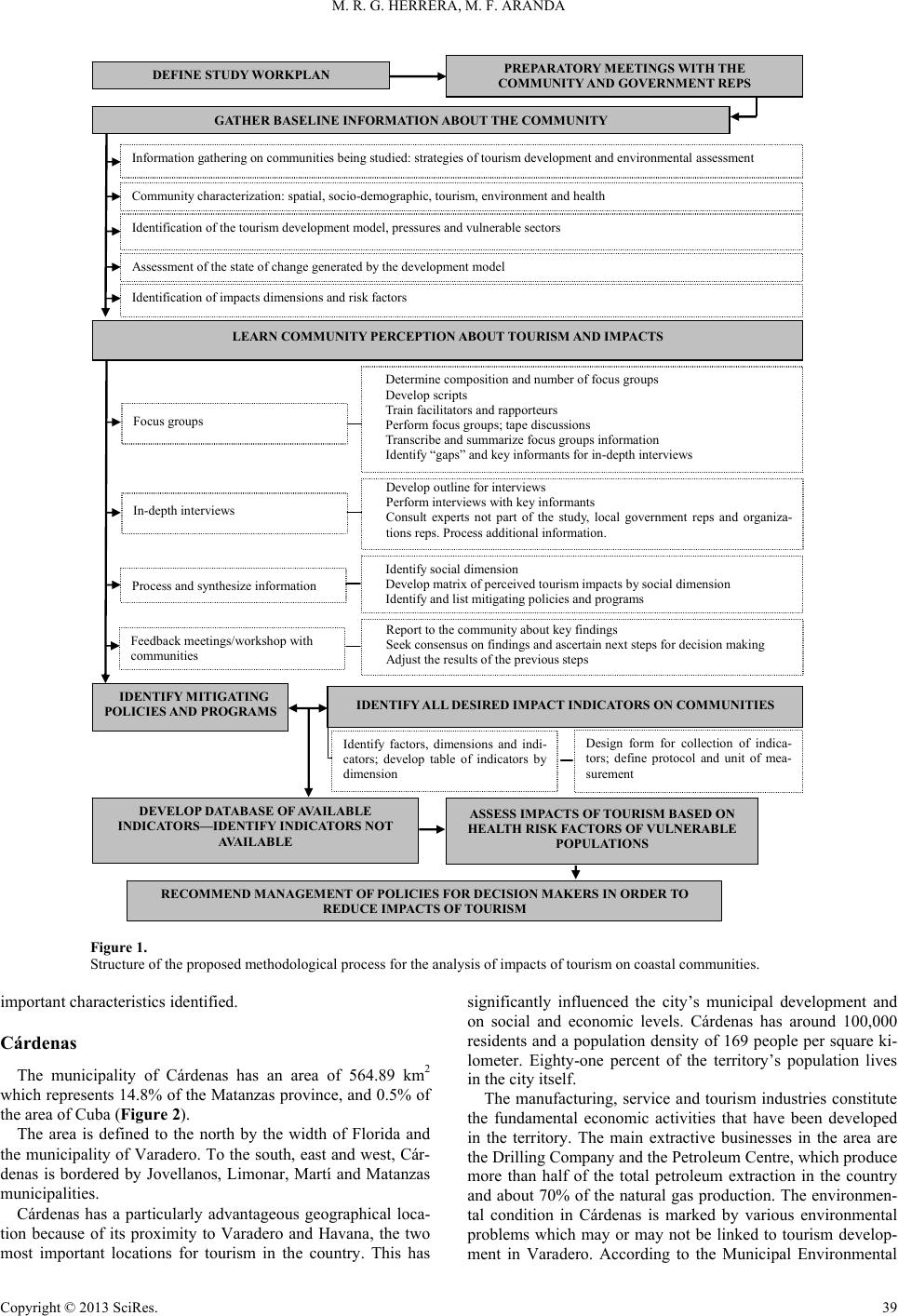 M. R. G. HERRERA, M. F. ARANDA Copyright © 2013 SciRes. 39 LEARN COMMUNITY PERCEPTION ABOUT TOURISM AND IMPACTS Focus group s Determine composition and number of focus groups Develop s cripts Train facilitators and rapporteurs Perform focus groups; tape discussions Transcribe a nd sum marize focus g r oups information Identify “gaps” and key informants for in-depth interviews In-depth interviews Process and synthesize information Feedback meetings/workshop with communities Develop outline for interv iews Perform interviews with key informants Consult experts not part of the study, local government reps and organiza- tions reps. Process additiona l information. Identify social dimension Develop matrix of perce ived tourism im pacts by social dimension Identify and list mitigating policies and programs Report to the community about key findings Seek consensus on findings and ascertain next steps for decision making Adjust the results of the previous steps DEVELOP DATABASE OF AVAILABLE INDICATORS—IDENTIFY INDICATORS NOT AVAILABLE ASSESS IM PACTS OF TOURISM BASED ON HEALTH RIS K FACTORS OF VULNERABLE POPULATIONS IDENTIFY A LL DESIRED IMPACT INDICATORS ON COMMUNITIES RECOMMEND MANAGEMENT OF POLICIES FOR DECISION MAKERS IN ORDER TO REDUCE IMPACTS OF TOURISM Identify factors, dimensions and indi- cators; develop table of indicators by dimension Design form for collection of indica- tors; define protocol and unit of mea- surement IDENTIFY MITIGATING POLICIES AND PROGRAMS DEFINE STUDY WORKPLAN PREPARATORY MEETINGS WITH THE COMMUNITY AND GOVERNMENT REPS GATHER BASELINE INFORMATION ABOUT THE COMMUNITY Information gathering on communities bei ng studied: strategies of tourism development and environmental assessment Community characterization: spatial, socio-demographic, tourism, environment and health Identification of the tourism development model, pressures and vulnerable sectors Assessment of the state of change generated by the development model Identification of impacts dimensions and risk factors Figure 1. Structure of the proposed methodological process for the analysis of impacts of tourism on coastal communities. significantly influenced the city’s municipal development and on social and economic levels. Cárdenas has around 100,000 residents and a population density of 169 people per square ki- lometer. Eighty-one percent of the territory’s population lives in the city itself. important char acteristics identified. Cárdenas The municipality of Cárdenas has an area of 564.89 km2 which represents 14.8% of the Matanzas province, and 0.5% of the area of Cuba (Figure 2). The manufacturing, service and tourism industries constitute the fundamental economic activities that have been developed in the territory. The main extractive businesses in the area are the Drilling Company and the Petroleum Centre, which produce more than half of the total petroleum extraction in the country and about 70% of the natural gas production. The environmen- tal condition in Cárdenas is marked by various environmental problems which may or may not be linked to tourism develop- ment in Varadero. According to the Municipal Environmental The area is defined to the north by the width of Florida and the municipality of Varadero. To the south, east and west, Cár- denas is bordered by Jovellanos, Limonar, Martí and Matanzas municipalities. Cárdenas has a particularly advantageous geographical loca- tion because of its proximity to Varadero and Havana, the two most important locations for tourism in the country. This has 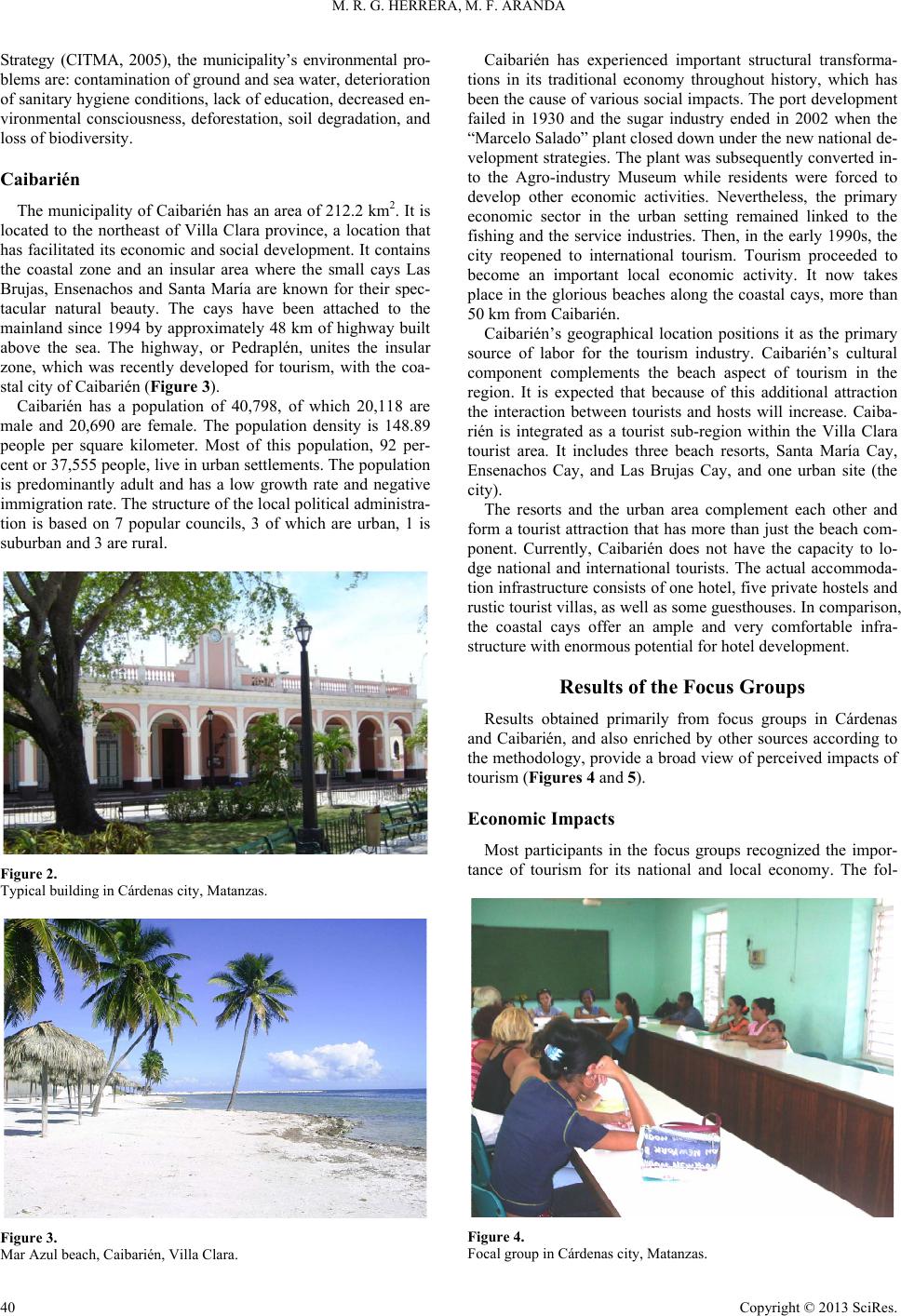 M. R. G. HERRERA, M. F. ARANDA Strategy (CITMA, 2005), the municipality’s environmental pro- blems are: contamination of ground and sea water, dete ri orat ion of sanitary hygiene conditions, lack of education, decreased en- vironmental consciousness, deforestation, soil degradation, and loss of biodiversity. Caibarién The municipality of Caibarién has an area of 212.2 km2. It is located to the northeast of Villa Clara province, a location that has facilitated its economic and social development. It contains the coastal zone and an insular area where the small cays Las Brujas, Ensenachos and Santa María are known for their spec- tacular natural beauty. The cays have been attached to the mainland since 1994 by approximately 48 km of highway built above the sea. The highway, or Pedraplén, unites the insular zone, which was recently developed for tourism, with the coa- stal city of Caibarién (Figure 3). Caibarién has a population of 40,798, of which 20,118 are male and 20,690 are female. The population density is 148.89 people per square kilometer. Most of this population, 92 per- cent or 37,555 people, live in urban settlements. The population is predominantly adult and has a low growth rate and negative immigration rate. The structure of the local political administra- tion is based on 7 popular councils, 3 of which are urban, 1 is suburban and 3 are rural. Figure 2. Typical building in Cárdenas city, Matanzas. Figure 3. Mar Azul beach, Caibarién, Villa Clara. Caibarién has experienced important structural transforma- tions in its traditional economy throughout history, which has been the cause of various social impacts. The port development failed in 1930 and the sugar industry ended in 2002 when the “Marcelo Salado” plant closed down under the new national de- velopment strategies. The plant was subsequently converted in- to the Agro-industry Museum while residents were forced to develop other economic activities. Nevertheless, the primary economic sector in the urban setting remained linked to the fishing and the service industries. Then, in the early 1990s, the city reopened to international tourism. Tourism proceeded to become an important local economic activity. It now takes place in the glorious beaches along the coastal cays, more than 50 km from Caibarién. Caibarién’s geographical location positions it as the primary source of labor for the tourism industry. Caibarién’s cultural component complements the beach aspect of tourism in the region. It is expected that because of this additional attraction the interaction between tourists and hosts will increase. Caiba- rién is integrated as a tourist sub-region within the Villa Clara tourist area. It includes three beach resorts, Santa María Cay, Ensenachos Cay, and Las Brujas Cay, and one urban site (the city). The resorts and the urban area complement each other and form a tourist attraction that has more than just the beach com- ponent. Currently, Caibarién does not have the capacity to lo- dge national and international tourists. The actual accommoda- tion infrastructure consists of one hotel, five private hostels and rustic tourist villas, as well as some guesthouses. In comparison, the coastal cays offer an ample and very comfortable infra- structure with enormous potential for hotel development. Results of the Focus Groups Results obtained primarily from focus groups in Cárdenas and Caibarién, and also enriched by other sources according to the methodology, provide a broad view of perceived impacts of tourism (Figures 4 and 5). Economic Impacts Most participants in the focus groups recognized the impor- tance of tourism for its national and local economy. The fol- Figure 4. Focal group in Cárdenas city, Matanzas. Copyright © 2013 SciRes. 40 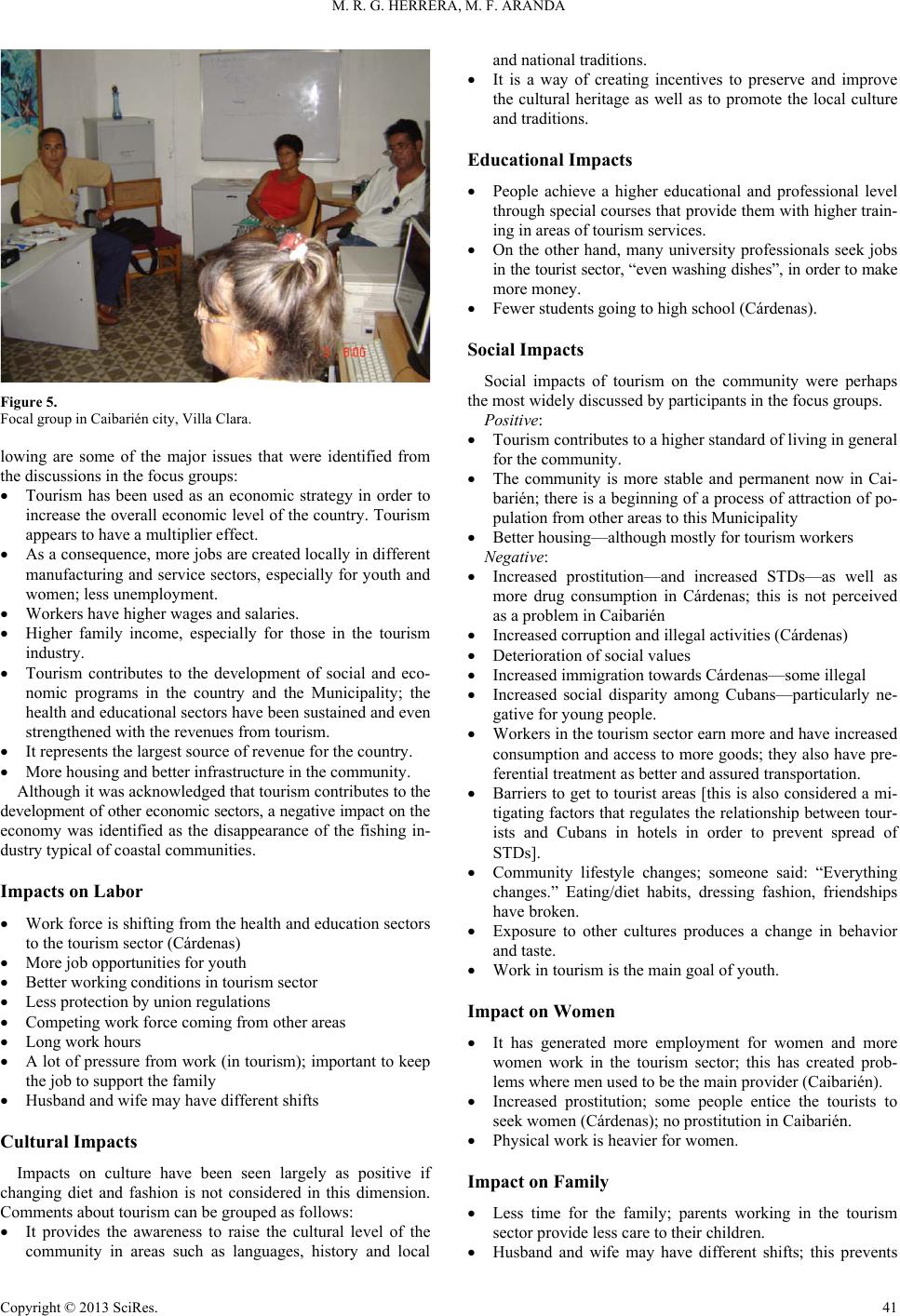 M. R. G. HERRERA, M. F. ARANDA Figure 5. p in Caibarién city, Villa Clara. wing are some of the major issues that were identified nomic strategy in order ated locally in diff salaries. se in the touris ontributes to the development of social and e countr de Impacts on Labor ing from the health and education sectors sector ther areas rom work (in tourism); important to k ifferent shifts Cultural Impacts have been seen largely as positive ch vel of incentives to preserve and improve Educational Impacts er educational and professional level professionals seek jobs going to high school (Cárdenas). Social Impacts of tourism on the community were perhaps th contributes to a higher standard of living in general re stable and permanent now in Cai- orkers prostitution—and increased STDs—as well as gal activities (Cárdenas) Cárdenas—some illegal e- arn more and have increased mi- ity lifestyle changes; someone said: “Everything ther cultures produces a change in behavior urism is the main goal of youth. Impact on Women ore employment for women and more Impact on Family family; parents working in the tourism ifts; this prevents Focal grou lo from for the community. The community is mo the discussions in the focus groups: Tourism has been used as an eco to barién; there is a beginning of a process of attraction of po- pulation from other areas to this Municipality Better housing—although mostly for tourism w increase the overall economic level of the country. Tourism appears to have a multiplier effect. As a consequence, more jobs are creerent Negative: manufacturing and service sectors, especially for yout h and women; less unemployment. Workers have higher wages and Higher family income, especially for thom more drug consumption in Cárdenas; this is not perceived as a problem in Caibarién Increased corruption and ille industry. Tourism ceco- Increased immigration towards nomic programs in the country and the Municipality; the health and educational sectors have been sustained and even strengthened with the revenues from tourism. It represents the largest source of revenue for thy. e consumption and access to more goods; they also have pre- ferential treatment as better and assu re d transp o rt a ti o n. Barriers to get to tourist areas [this is also considered a More housing and better infrastructure in the community. Although it was acknowledged that tourism contributes to th velopment of other economic sectors, a negative impact on t he economy was identified as the disappearance of the fishing in- dustry typical of coastal communities. Work force is shift c to the tourism sector (Cárdenas) More job opportunities for youth Better working conditions in tourism Less protection by union regulations Competing work force coming from o Long work hours A lot of pressure feep women work in the tourism sector; this has created prob- lems where men used to be the main provider (Caibarién). Increased prostitution; some people entice the tourists to the job to support the family Husband and wife may have d Impacts on culture if anging diet and fashion is not considered in this dimension. Comments about tourism can be grouped as follows: It provides the awareness to raise the cultural lethe sector provide less care to their children. Husband and wife may have different sh community in areas such as languages, history and local and national traditions. It is a way of creating the cultural heritage as well as to promote the local culture and traditions. People achieve a high through special courses that provide them with higher train- ing in areas of tourism services. On the other hand, many university in the tourist sector, “even washin g dishes”, in order to make more money. Fewer students Social impacts e most widely discussed by participants in the focus groups. Positive: Tourism Increased Deterioration of social values Increased social disparity among Cubans—particularly n gative for young people. Workers in the tourism sector e tigating factors that regulates the relationship between tour- ists and Cubans in hotels in order to prevent spread of STDs]. Commun hanges.” Eating/diet habits, dressing fashion, friendships have broken. Exposure to o and taste. Work in to It has generated m seek women (Cárdenas); no prostitution in Caibarién. Physical work is heavier for women. Less time for the Copyright © 2013 SciRes. 41 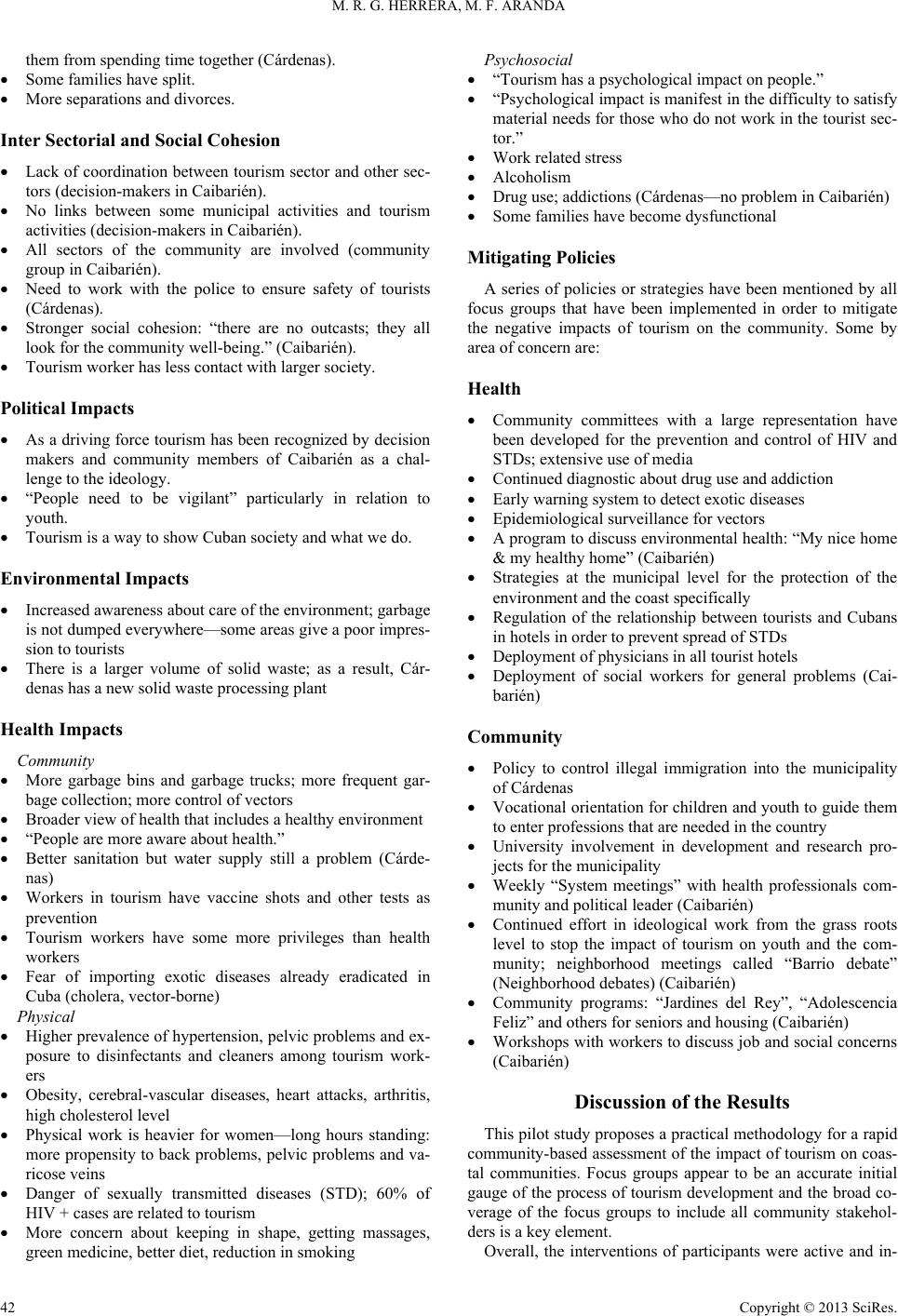 M. R. G. HERRERA, M. F. ARANDA them from spending time together (Cárdenas). Some families have split. More separations and divorces. Inter Sectorial and Social Cohesion sector and other activities and tourism lved (community he police to ensure safety of tourists ial cohesion: “there are no outcasts; they all Political Impacts been recognized by decision gilant” particularly in relation s a way to show Cuban society and what we do Environmental Impacts t care of the environment; ga r volume of solid waste; as a result, Health Impacts ge bins and garbage trucks; more frequent gar- althy environm a problem (C ers in tourism have vaccine shots and other tests rkers have some more privileges than health importing exotic diseases already eradicated revalence of hypertension, pelvic problems and ex- sity, cerebral-vascular diseases, heart attacks, arthriti er for women—long hours standing: exually transmitted diseases (STD); 60% of hape, getting massages, a psychological impact on people.” to satisfy related stress dictions (Cárdenas—no problem in Caibarién) Mitigating Policies r strategies have been mentioned by all fo Health unity committees with a large representation have use and addiction : “My nice home for the protection of the tourists and Cubans oblems (Cai- Community ntrol illegal immigration into the municipality tation for children and youth to guide them rch pro- ” with health professionals com- rom the grass roots Rey”, “Adolescencia cerns Discussion of the Results This pilot stugy for a rapid co tions of participants were active and in- Lack of coordination between tourism sec- Alcoholism tors (decision-makers in Caibarién). No links between some municipal activities (decision-makers in Caibarién). All sectors of the community are invo group in Caibarién). Need to work with t (Cárdenas). Stronger soc look for the community well-being.” (Caibarién). Tourism worker has less contact with larger society. As a driving force tourism has b makers and community members of Caibarién as a chal- lenge to the ideology. “People need to be vi to Early warning system to detect exotic diseases youth. Tourism i. A program to discuss environmental health Increased awareness abourbage environment and the coast specifically Regulation of the relationship between is not dumped everywhere—some areas give a poor impres- sion to tourists There is a large Cár- Deployment of social workers for general pr denas has a new solid waste processing plant Community More garba o bage collection; more control of vectors Broader view of health that includes a heent to enter professions that are needed in the country University involvement in development and resea “People are more aware about health.” Better sanitation but water supply still árde- jects for the municipality Weekly “System meetings nas) Work as munity and political leader (Caibarién) Continued effort in ideological work f prevention Tourism wo workers Fear of in level to stop the impact of tourism on youth and the com- munity; neighborhood meetings called “Barrio debate” (Neighborhood debates) (Caibarién) Community programs: “Jardines del Cuba (cholera, vector-borne) Physical Higher p F posure to disinfectants and cleaners among tourism work- ers Obes, (Caibarién) high cholesterol level Physical work is heavi more propensity to back problems, pelvic problems and va- ricose veins Danger of s HIV + cases are related to tourism More concern about keeping in s green medicine, better diet, reduction in smoking Psychosocial “Tourism has “Psychological impact is manifest in the difficulty material needs for those who do not work in the tourist sec- tor.” Work Drug use; ad Some families have become dysfunctional A series of policies o cus groups that have been implemented in order to mitigate the negative impacts of tourism on the community. Some by area of concern are: Comm een developed for the prevention and control of HIV and STDs; extensive use of media Continued diagnostic about drug Epidemiological surveillance for vectors & my healthy home” (Caibarién) Strategies at the municipal level in hotels in order to prevent spread of STDs Deployment of physicians in all tourist hotels barién) Policy to co f Cárdenas Vocational orien eliz” and others for seniors and housing (Caibarién) Workshops with workers to discuss job and social con dy proposes a practical methodolo mmunity-based assessment of the impact of tourism on coas- tal communities. Focus groups appear to be an accurate initial gauge of the process of tourism development and the broad co- verage of the focus groups to include all community stakehol- ders is a key element . Overall, the interven Copyright © 2013 SciRes. 42 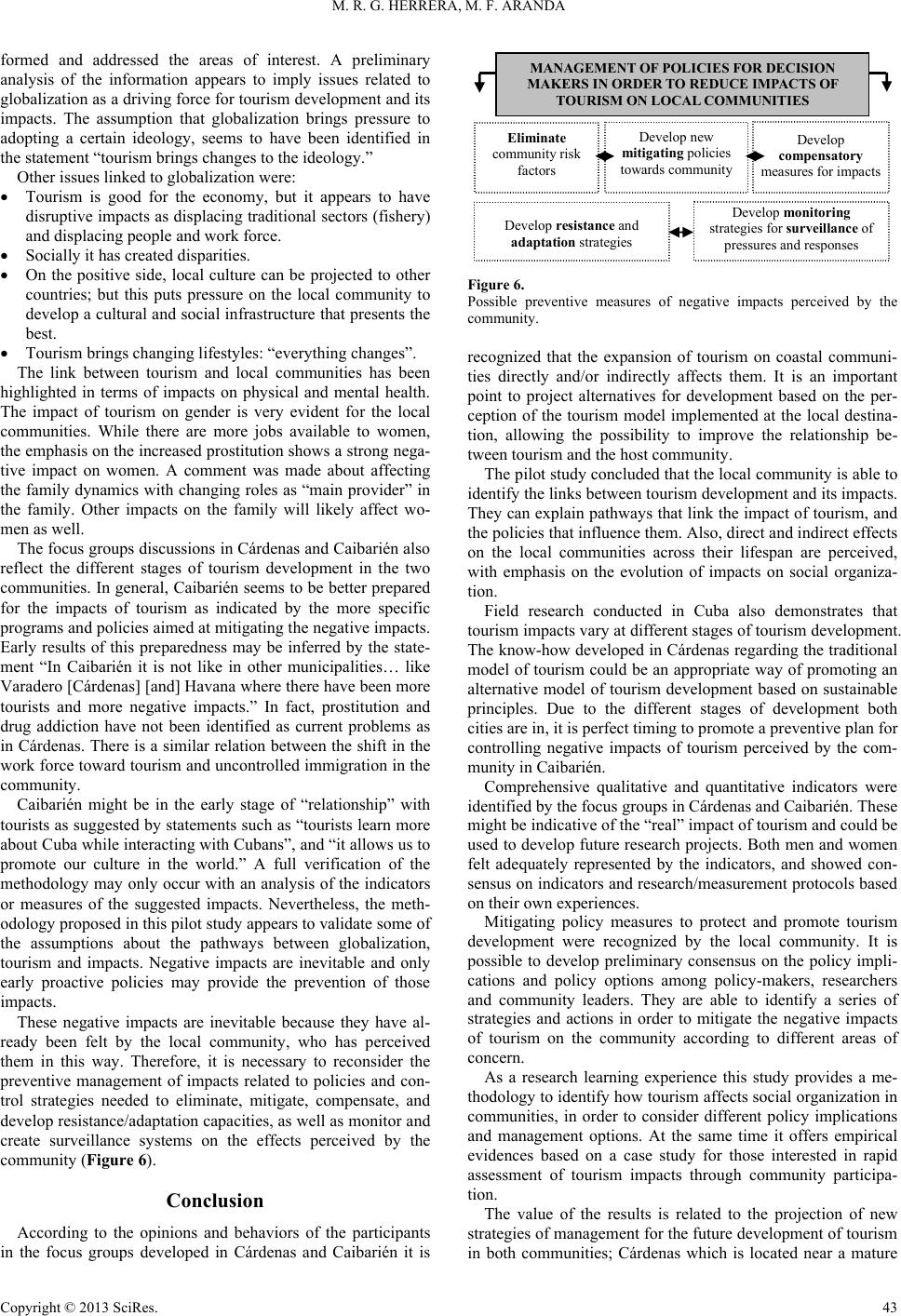 M. R. G. HERRERA, M. F. ARANDA fo it appears to have can be projected to other m brings changing lifestyles: “every thing changes”. hi roups discussions in Cárdenas and Caibarién also re ight be in the early stage of “relationship” with to egative impacts are inevitable because they have al- re Conclusion According to the opiiors of the participants in rmed and addressed the areas of interest. A preliminary analysis of the information appears to imply issues related to globalization as a driving force for tourism development and its impacts. The assumption that globalization brings pressure to adopting a certain ideology, seems to have been identified in the statement “tourism brings changes to the ideology.” Other issues linked to globalization were: Tourism is good for the economy, but disruptive impacts as displacing traditional sectors (fishery) and displacing people and work force. Socially it has created disparities. On the positive side, local culture countries; but this puts pressure on the local community to develop a cultural and social infrastructure that presents the best. Touris The link between tourism and local communities has been ghlighted in terms of impacts on physical and mental health. The impact of tourism on gender is very evident for the local communities. While there are more jobs available to women, the emphasis on the increased prostitution shows a strong nega- tive impact on women. A comment was made about affecting the family dynamics with changing roles as “main provider” in the family. Other impacts on the family will likely affect wo- men as well. The focus g flect the different stages of tourism development in the two communities. In general, Caibarién seems to be better prepared for the impacts of tourism as indicated by the more specific programs and policies aimed at mitigating the negative impacts. Early results of this preparedness may be inferred by the state- ment “In Caibarién it is not like in other municipalities… like Varadero [Cárdenas] [and] Havana where there have been more tourists and more negative impacts.” In fact, prostitution and drug addiction have not been identified as current problems as in Cárdenas. There is a similar relation between the shift in the work force toward tourism and uncontrolled immigration in the community. Caibarién m urists as suggested by statements such as “tourists learn more about Cuba while interacting with Cubans”, and “it allows us to promote our culture in the world.” A full verification of the methodology may only occur with an analysis of the indicators or measures of the suggested impacts. Nevertheless, the meth- odology proposed in this pilot study appears to validate some of the assumptions about the pathways between globalization, tourism and impacts. Negative impacts are inevitable and only early proactive policies may provide the prevention of those impacts. These n ady been felt by the local community, who has perceived them in this way. Therefore, it is necessary to reconsider the preventive management of impacts related to policies and con- trol strategies needed to eliminate, mitigate, compensate, and develop resistance/adaptation capacities, as well as monitor and create surveillance systems on the effects perceived by the community (Figure 6). nions and behav the focus groups developed in Cárdenas and Caibarién it is MANAGEMENT OF POLICIES FOR DECISION MAKERS IN ORDER TO REDUCE IMPACTS OF TOURISM ON LOCAL COMMUNITIES Develop new mitiga ti n g policies towards community Eliminate community risk factors Develop compensatory measures for impacts Develop monitori n strategies for surveillance of pressures and responses Develop resistance and adaptation strategies Figure 6. reventive measures of negative impacts perceived by the cognized that the expansion of tourism on coastal communi- munity is able to id research conducted in Cuba also demonstrates that to alitative and quantitative indicators were id es to protect and promote tourism de search learning experience this study provides a me- th alue of the results is related to the projection of new st Possible p community. re ties directly and/or indirectly affects them. It is an important point to project alternatives for development based on the per- ception of the tourism model implemented at the local destina- tion, allowing the possibility to improve the relationship be- tween tourism and the host community. The pilot study concluded that the local com entify the links between tourism development and its impacts. They can explain pathways that link the impact of tourism, and the policies that influence them. Also, direct and indirect effects on the local communities across their lifespan are perceived, with emphasis on the evolution of impacts on social organiza- tion. Field urism impacts vary at different stages of tourism development. The know-how developed in Cárdenas regarding the traditional model of tourism could be an appropriate way of promoting an alternative model of tourism development based on sustainable principles. Due to the different stages of development both cities are in, it is perfect timing to promote a preventive plan for controlling negative impacts of tourism perceived by the com- munity in Caibarién. Comprehensive qu entified by the focus groups in Cárdenas and Caibarién. These might be indicative of the “real” impact of tourism and could be used to develop future research projects. Both men and women felt adequately represented by the indicators, and showed con- sensus on indicators and research/measurement protocols based on their own experiences. Mitigating policy measur velopment were recognized by the local community. It is possible to develop preliminary consensus on the policy impli- cations and policy options among policy-makers, researchers and community leaders. They are able to identify a series of strategies and actions in order to mitigate the negative impacts of tourism on the community according to different areas of concern. As a re odology to identify how tourism affects social organization in communities, in order to consider different policy implications and management options. At the same time it offers empirical evidences based on a case study for those interested in rapid assessment of tourism impacts through community participa- tion. The v rategies of management for the future development of tourism in both communities; Cárdenas which is located near a mature Copyright © 2013 SciRes. 43 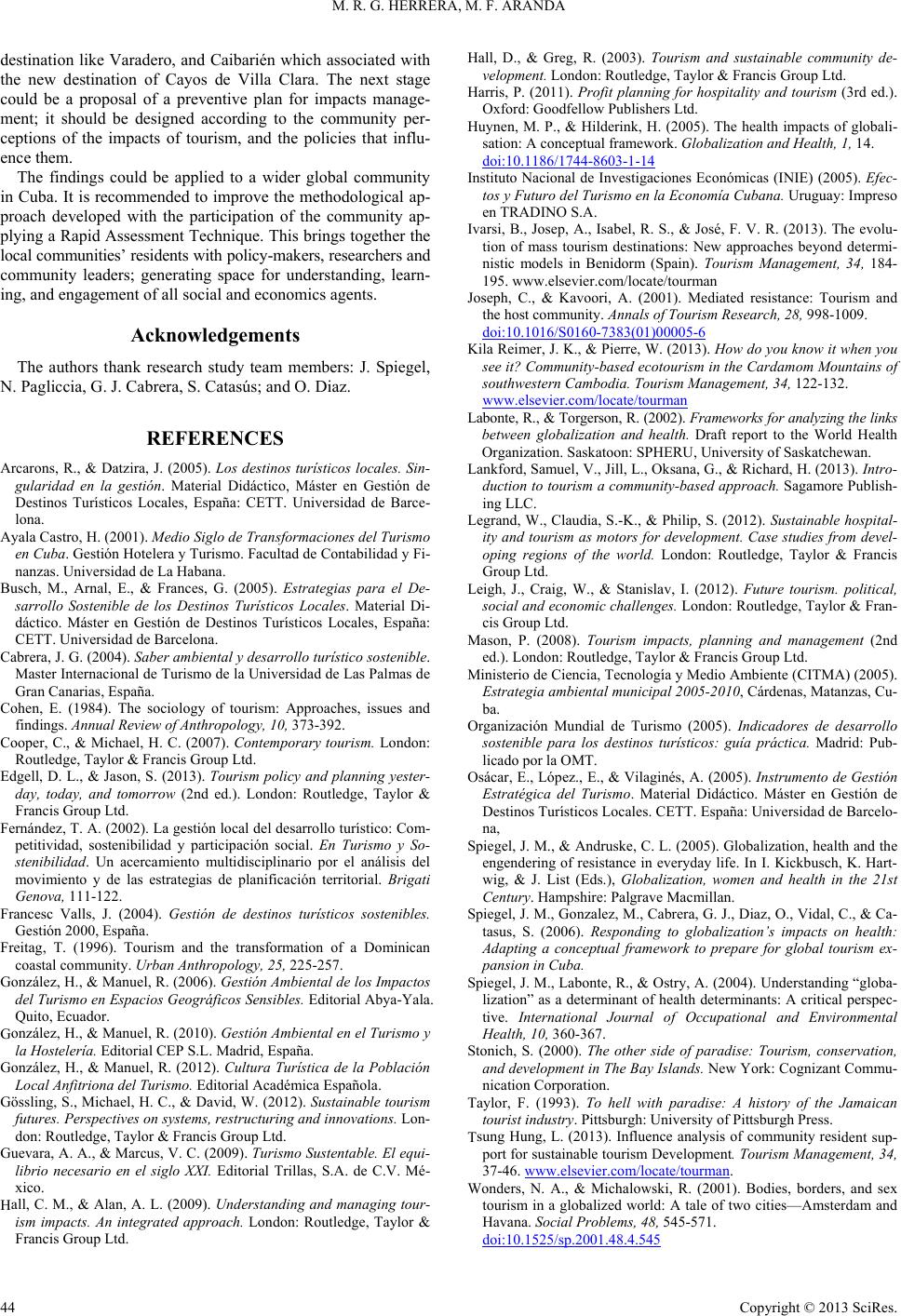 M. R. G. HERRERA, M. F. ARANDA destination like Varadero, and Caibarién which associated with the new destination of Cayos de Villa Clara. The next stage could be a proposal of a preventive plan for impacts manage- ment; it should be designed according to the community per- ceptions of the impacts of tourism, and the policies that influ- ence them. The findings could be applied to a wider global community in Acknowledgements The authors thambers: J. Spiegel, N REFERENCES Arcarons, R., & Datziraturísticos locales. Sin- A B. Estrategias para el De- C desarrollo turístico sostenible. C Csm. London: Fa gestión local del desarrollo turístico: Com- Fr4). Gestión de destinos turísticos sostenibles. G los Impactos G Ga de la Población Gurism Gustentable. El equi- H H. Tourism and sustainable community de- H.). Hhe health impacts of globali- Cuba. It is recommended to improve the methodological ap- proach developed with the participation of the community ap- plying a Rapid Assessment Technique. This brings together the local communities’ residents with policy -makers, researchers and community leaders; generating space for understanding, learn- ing, and engage me nt of all social and economics agents. nk research study team me . Pagliccia, G. J. Cabrera, S. Catasús; and O. Diaz. , J. (2005). Los destinos gularidad en la gestión. Material Didáctico, Máster en Gestión de Destinos Turísticos Locales, España: CETT. Universidad de Barce- lona. yala Castro, H. (2001). Medio Siglo de Transformaciones del Turismo en Cuba. Gestión Hotelera y Turismo. Facultad de Contabilidad y Fi- nanzas. Universidad de La Habana. usch, M., Arnal, E., & Frances, G. (2005) sarrollo Sostenible de los Destinos Turísticos Locales. Material Di- dáctico. Máster en Gestión de Destinos Turísticos Locales, España: CETT. Universidad de Ba rcelona. abrera, J. G. (2004). Saber ambiental y Master Internacional de Turismo de la Universidad de Las Palmas de Gran Canarias, España. ohen, E. (1984). The sociology of tourism: Approaches, issues and findings. A nn u al Review of Anthropology, 10, 373-392. ooper, C., & Michael, H. C. (2007). Contemporary touri Routledge, Tayl or & Francis Group Lt d . Edgell, D. L., & Jason, S. (2013). Tourism policy and planning yester- day, today, and tomorrow (2nd ed.). London: Routledge, Taylor & Francis Group Ltd. ernández, T. A. (2002). L petitividad, sostenibilidad y participación social. En Turismo y So- stenibilidad. Un acercamiento multidisciplinario por el análisis del movimiento y de las estrategias de planificación territorial. Brigati Genova, 111-122. ancesc Valls, J. (200 Gestión 2000, España. Freitag, T. (1996). Tourism and the transformation of a Dominican coastal community. Urban Anthropology, 25, 225-257. onzález, H., & Manuel, R. (2006). Gestión Ambiental de del Turismo en Espacios Geográficos Sensibles. Editorial Abya-Yala. Quito, Ecuador. onzález, H., & Manuel, R. (2010). Gestión Ambiental en el Turismo y la Hostelería. Editorial CEP S.L. Madrid, España. onzález, H., & Manuel, R. (2012). Cultura Turístic Local Anfitriona del Turismo. Editorial Académica Española. össling, S., Michael, H. C., & David, W. (2012). Sustainable to futures. Perspectives on systems, restructuring and innovations. Lon- don: Routledge, Taylor & Francis Group Ltd. uevara, A. A., & Marcus, V. C. (2009). Turismo S librio necesario en el siglo XXI. Editorial Trillas, S.A. de C.V. Mé- xico. all, C. M., & Alan, A. L. (2009). Understanding and managing tour- ism impacts. An integrated approach. London: Routledge, Taylor & Francis Group Ltd. all, D., & Greg, R. (2003) velopment. London: Routledge, Taylor & Francis Group L td. arris, P. (2011). Profit planning for hospitality and tourism (3rd ed Oxford: Goodfellow P ublishers Ltd. uynen, M. P., & Hilderink, H. (2005). T sation: A conceptual framew ork. Globalization and H e alth, 1, 14. doi:10.1186/1744-8603-1-14 stituto Nacional de InvestigaciIn ones Económicas (INIE) (2005). Efec- Iv R. S., & José, F. V. R. (2013). The evolu- Jod resistance: Tourism and tos y Futuro del Turismo en la Economía Cubana. Uruguay: Impreso en TRADINO S.A. arsi, B., Josep, A., Isabel, tion of mass tourism destinations: New approaches beyond determi- nistic models in Benidorm (Spain). Tourism Management, 34, 184- 195. www.elsevier.com/locate/tourman seph, C., & Kavoori, A. (2001). Mediate the host community. Annals of Tourism Research, 28, 998-1009. doi:10.1016/S0160-7383(01)00005-6 ila Reimer, J. K., & Pierre, W. (2013). KHow do you know it when you see it? Community-based ecotourism in the Cardamom Mountains of southwestern Cambodia. Tourism Management, 34, 122-132. www.elsevier.com/locate/tourman abonte, R., & Torgerson, R. (2002). FraLmeworks for an alyzing th e lin ks L- Legrand, W., Claudia, S.-K., & Philip, S. (2012). Sustainable hospital- LW., & Stanislav, I. (2012). Future tourism. political, M planning and management (2nd MA) (2005). Organización Mundial de Turismo (2005). Indicadores de desarrollo Osácar, E., López., E., & Vilaginés, A. (2005). Instrumento de Gestión S., & Andruske, C. L. (2005). Globalization, health and the Siaz, O., Vidal, C., & Ca- S, R., & Ostry, A. (2004). Understanding “globa- Sther side of paradise: Tourism, conservation, Tll with paradise: A history of the Jamaican Tdent sup- between globalization and health. Draft report to the World Health Organization. Saskatoon: SPHERU, University of Saskatchewan. ankford, Samuel, V., Jill, L., Oksana, G., & Richard, H. (2013). Intro duction to tourism a community-based approach. Sagamore Publish- ing LLC. ity and tourism as motors for development. Case studies from devel- oping regions of the world. London: Routledge, Taylor & Francis Group Ltd. eigh, J., Craig, social and economic challenges. London: Routledge, Taylor & Fran- cis Group Ltd. ason, P. (2008). Tourism impacts, ed.). London: Routledge, Taylor & Francis Group Ltd. inisterio de Ciencia, Tecnología y Medio Ambiente (CITM Estrategia ambiental municipal 2005-2010, Cárdenas, Matanzas, Cu- ba. sostenible para los destinos turísticos: guía práctica. Madrid: Pub- licado por la OMT. Estratégica del Turismo. Material Didáctico. Máster en Gestión de Destinos Turísticos Locales. CETT. España: Universidad de Barcelo- na, piegel, J. M engendering of resistance in everyday life. In I. Kickbusch, K. Ha rt- wig, & J. List (Eds.), Globalization, women and health in the 21st Century. Hampshire: Palg r ave Macmillan. piegel, J. M., Gonzalez, M., Cabrera, G. J., D tasus, S. (2006). Responding to globalization’s impacts on health: Adapting a conceptual framework to prepare for global tourism ex- pansion in Cuba. piegel, J. M., Labonte lization” as a determinant of health determinants: A critical perspec- tive. International Journal of Occupational and Environmental Health, 10, 360-367. tonich, S. (2000). The o and development in The Bay Islands. New York: Cognizant Commu- nication Corporation. aylor, F. (1993). To he tourist industry. Pittsburgh: University of Pittsburgh Press. sung Hung, L. (2013). Influence analysis of community resi port for sustainable tourism Development. Tourism Management, 34, 37-46. www.elsevier.com/locate/tourman. onders, N. A., & Michalowski, R. (2001). BWodies, borders, and sex tourism in a globalized world: A tale of two cities—Amsterdam and Havana. Social Problems, 48, 545-571. doi:10.1525/sp.2001.48.4.545 Copyright © 2013 SciRes. 44 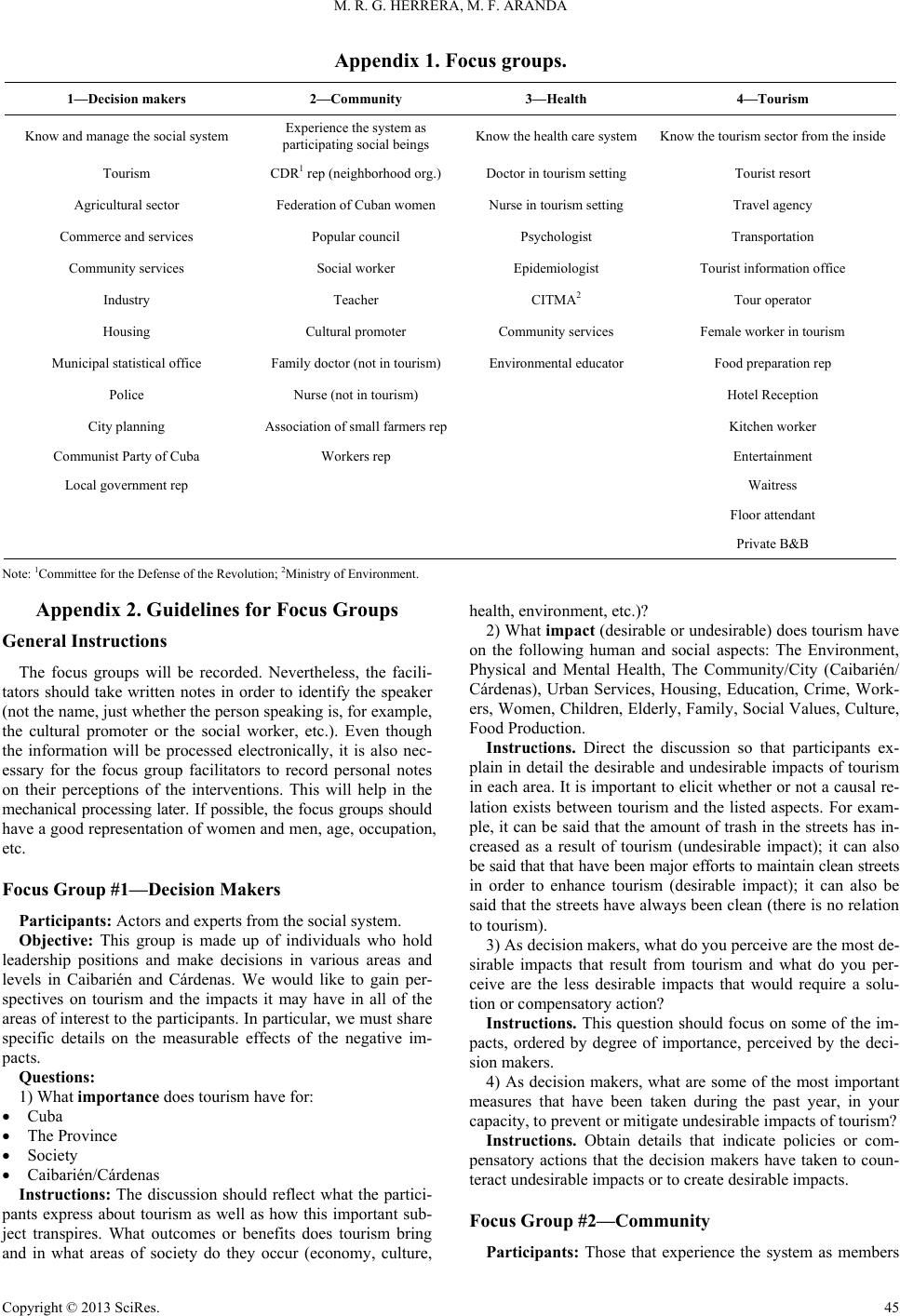 M. R. G. HERRERA, M. F. ARANDA Copyright © 2013 SciRes. 45 Appendix 1. Focus groups. 1—Decision makers 2—Community 3—Health 4—Tourism Know and manage the social system Exp as Know the health care systemKnow the tourism sector from the inside erience the system participating social beings Tourism C) Doctor in tourism setting Tourist resort Agricctor Coes EpideTouriice Cultuoter Commes Femasm Municipaal office Familysm) E Cityng Assocp Comm Cuba Flont DR1 rep (nei g hborhood or g. ultural seFederation of Cuban wom en Nurse in tourism setting Travel age ncy mmerce and servicPopular council Psychologist Transporta t ion Community services Soci al worker miologist st information off Industry Teacher CITMA2 Tour operator Housing ral promuni t y servicle worker in to u r i l statisti c doc to r (n ot in tourinvironmental educa tor Food prepa r ation rep Police Nurs e (not in touri sm) Hotel Receptio n planniiation of small farmers re Kitchen worker unist Party ofWorkers rep Entertainment Local government rep Waitress or attenda Private B&B Note: 1Committee for the of the Revolution; 2Ministry of Evironment. Appendix 2. Guidelines for Focus Groups Gen be recorded. Nevertheless, the facili- ta Focus Group #1—Decision Makers he social system. old le stions: ortance does tourism have for: ovince /Cárdenas cussion should reflect what the partici- pa health, environment, etc.)? d social aspects: The Environment, Ph esirable and undesirable impacts of tourism in ts that result from tourism and what do you per- ce portance, perceived by the deci- si have been taken during the past year, in your ca te Participants: Those that experience the system as members e Defensn eral Instructions The focus groups will tors should take written notes in order to identify the speaker (not the name, just whether the person speaking is, for example, the cultural promoter or the social worker, etc.). Even though the information will be processed electronically, it is also nec- essary for the focus group facilitators to record personal notes on their perceptions of the interventions. This will help in the mechanical processing later. If possible, the focus groups should have a good representation of women and men, age, occupation, etc. Participants: Actors and experts from t Objective: This group is made up of individuals who h adership positions and make decisions in various areas and levels in Caibarién and Cárdenas. We would like to gain per- spectives on tourism and the impacts it may have in all of the areas of interest to the participants. In particular, we must share specific details on the measurable effects of the negative im- pacts. Que 1) What imp Cuba The Pr Society Caibarién Instructions: The dis nts express about tourism as well as how this important sub- ject transpires. What outcomes or benefits does tourism bring and in what areas of society do they occur (economy, culture, 2) What impact (desirable or undesirable) does tourism have on the following human an ysical and Mental Health, The Community/City (Caibarién/ Cárdenas), Urban Services, Housing, Education, Crime, Work- ers, Women, Children, Elderly, Family, Social Values, Culture, Food Production. Instructions. Direct the discussion so that participants ex- plain in detail the d each area. It is important to elicit whether or not a causal re- lation exists between tourism and the listed aspects. For exam- ple, it can be said that the amount of trash in the streets has in- creased as a result of tourism (undesirable impact); it can also be said that that have been major efforts to maintain clean streets in order to enhance tourism (desirable impact); it can also be said that the streets have always been clean (there is no relation to tourism). 3) As decision makers, what do you perceive are the most de- sirable impac ive are the less desirable impacts that would require a solu- tion or compensatory action? Instructions. This question should focus on some of the im- pacts, ordered by degree of im on makers. 4) As decision makers, what are some of the most important measures that pacity, to prevent or mitigate undesirable impacts of tourism? Instructions. Obtain details that indicate policies or com- pensatory actions that the decision makers have taken to coun- ract undesirable impacts or to create desirable impacts. Focus Group #2—Community  M. R. G. HERRERA, M. F. ARANDA of society. Make sure that there is equal representation from m nas he discussion should obtain participants’ re- tourism at different leve ls from the Participants: Those familiar with health from the perspec- who work in tourism and th n for children. do not work in to e children or partner, practicing religion, or listening to through direct ex- omen are equally represented, and racial groups, in or irect impacts. The pa ce ién/Cárdenas he discussion should obtain participants’ re- e relevance of tourism on different levels from : tions between workers, differences between area of work, why some fishermen now s with spouses, children, parents, friends, etc. a- , maintaining or getting work at a ntented, demoralized, en and women, those single and married, and from various occupations in order to capture diverse perspectives. Objective: The group will be made up of participants that DO NOT work in tourism and represent a cross section of the cohey experience the impacts of tourismmmunity. T in many areas including (and especially) health. This impact is as much physical as mental, and impact areas on a socio-environmental level and in the community without necessarily benefiting di- rectly from tourism. The objective is to obtain participants’ per- spectives on tourism and its impacts both on a personal level and on the community of Caibarién/Cárdenas. Questions: 1) What importance does tourism have on: Cuba The Province y Societ Caibar ién/Cárde ons. TInstructi flections on the relevance of general level to more specific impacts on a personal level. 2) What is your opinion on how your community is develop- ping tourism and what do you perceive are the changes that have occurred because of tourism? Instructions. Facilitate a discussion about how changes have been perceived regarding the environment, changes socially and culturally, changes to physical and mental health, changes in negative behaviors (like alcohol use, etc.) and positive changes (like housing improvements, etc.). Try to cover the majority of human and social aspects. 3) What specific actions have been taken to counteract the changes that you have perceived as negativ e? Instructions. Obtain details from actions that individuals have taken in their communities against the undesirable impacts on environmental, social, cultural, physical and mental health levels. Focus Group #3—Health tive of tourism workers. Objective: This group is comprised of individuals who through their work have a good understanding of health issues. The participants work in tourism or are very familiar with tou- rism. We want to establish a description of health in the broad- est sense through the eyes of those in the tourism sector. There are four areas of focus: physical health, mental health, stress, and protective/compensatory factors. Questions: 1) What is your perception of the changes to physical health thate to tourism in people t you attribu ose who do not? Instructions. Focus on respiratory and sexually transmitted diseases, obesity, etc. (have the list of health indicators ready). 2) What is your perception of the changes to mental health that you attribute to tourism in people who work in tourism and those who do not? Instructions. Focus on the occurrence of depression, anxiety, alcoholism, sleeping disorders and other mental health factors that emerge from the group discussion. 3) What is your perception of the changes to stress occur- rence/levels that you attribute to tourism in people who work in tourism and those who do not? Instructions. Facilitate a discussion of work-related stress, interpersonal (couples and family) stress, economic stress, and stress around providing educatio 4) What is your perception of individual or community ac- tions taken to mitigate or prevent the occurrence of stress or mental health disorders in people who work or urism? Instructions. Facilitate a discussion around personal strate- gies to lessen the effects of stress, for example, taking personal time for th music. For the c ommunity level, discuss how community or- ganizations and the community as a whole, as well as cultural activities, etc., help to alleviate stress. Focus Group #4—Tourism Participants: Those familiar with tourism perience. Make sure men and w as well as single and married individuals der to capture a diversity of perspectives. Objective: The group is comprised of people who work in tourism (from managers to cleaning staff) or who are directly linked to the sector and who experience d rticipants experience the effects of tourism on health and its links to the environment. Questions: 1) What importance does tourism have on: Cuba The Provin Society Caibar Instructions. T flections on th general to personal. 2) What experiences have been significant for you in the tourism industry? Instructions. a) In the following areas, try to cover your experiences with working in tourism Labor—Rela various areas of tourism work, what it means to have to switch to another work in the service industry or technical work instead of as fishermen. Relationships with family, partner, and friends—Discuss whether there have been changes in the time and quality of relationship Children’s Education—Facilitate the sharing of personal anecdotes about how children are affected by working pa- rents. How? Positive; negative; how, for example, has beh vior changed, and why? Economic Impact—Discuss whether the participants feel more economic responsibility within the family, if there is stress around losing work hotel or in other tourism-related work. Emotional—Discuss on a personal level the emotional im- pact of tourism. How does it feel to work in tourism? For example, happy, at ease, hopeful, disco deceived, indifferent, etc. Social and Cultural—Discuss whether they have experi- enced changes in the way they relate to or behave in their Copyright © 2013 SciRes. 46 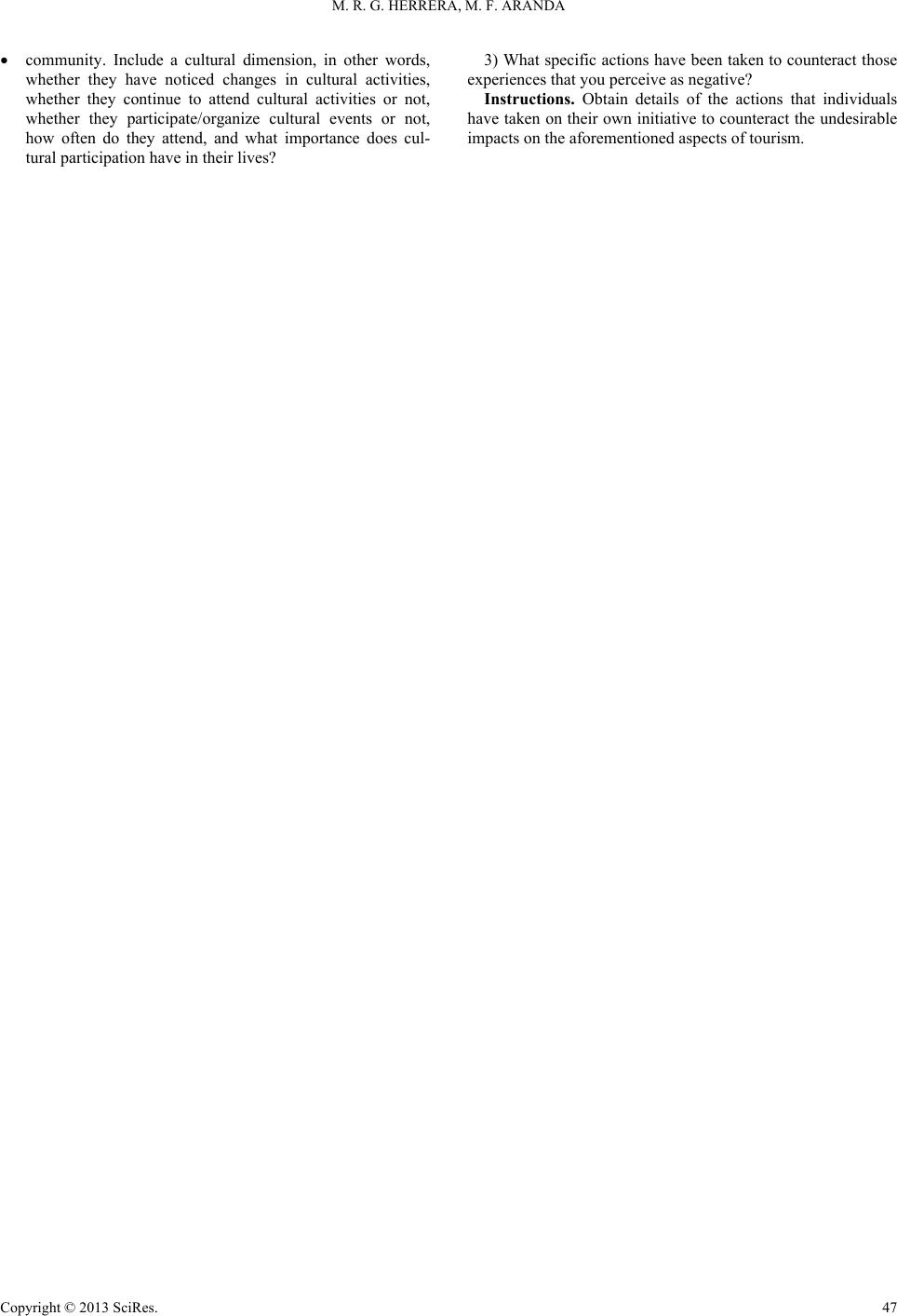 M. R. G. HERRERA, M. F. ARANDA Copyright © 2013 SciRes. 47 tural dimension, in other words, n to counteract those ex ns that individuals ha community. Include a cul whether they have noticed changes in cultural activities, whether they continue to attend cultural activities or not, whether they participate/organize cultural events or not, how often do they attend, and what importance does cul- tural participation have in their lives? 3) What specific actions have been take periences that you perceive as negative? Instructions. Obtain details of the actio ve taken on their own initiative to counteract the undesirable impacts on the aforementioned aspects of tourism.
|